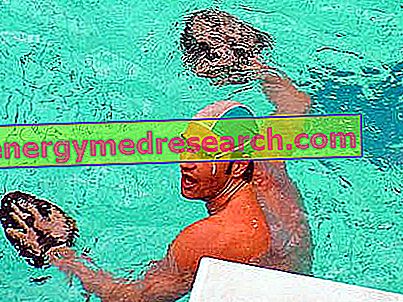By Dr. Andrea Bondanini
Strength can also be developed in water. While on the one hand the exercises cannot reach very high intensities, on the other they are more specific exercises, since they use the gesture of competition, and thus develop precisely the muscles used in the swim.
The main method is to create greater friction and resistance to the swimmer, or to put him in a position to exert more strength with each stroke or leg.
The use of these tools is not reserved only for expert swimmers, but it concerns anyone who has a minimum confidence in the water and is able to swim discreetly in some tanks in succession.
Sometimes, also due to the need to vary training stimuli, it can be useful to use always different tools to develop strength. Let's start with the most common and popular ones, valid for all:
Handheld palettes:
On the market there are special palmar palettes which, applied to the hands, allow to develop more strength in the water. With them it is possible to swim even for half the seat, and to better isolate the arms, it is possible to add an elastic band to the ankles (see below) combined with a pull buoy, to float the legs and concentrate only on the arms.

Mini-palette
This model of palettes, smaller than the classic ones, exerts a resistance that forces the muscle of the



they can be used to isolate the movement of the legs to concentrate on it and train them more effectively. In fact, during the complete swim, the legs perform only a stabilizing and not very propulsive action, apart from the frog; therefore they do not work very often. For this reason, with the tablet it is possible to train them better, perhaps alternating between tanks with a bland pace, with others at higher rates. You can even take the time of these tubs to legs with the tablet to note the improvements. To avoid annoying pains or aches in the shoulders it is advisable to use the tablet for no more than 15 minutes; it is possible to alternate work and exercises with the table to others with the complete swim.
Elastic ankles
They are common black elastics, obtained from the inner tubes of cars or heavy vehicles, cut into "slices" of 2-5 cm, which go to hold the ankles, then the legs, preventing their movement. For beginners it is possible to combine their use with pull-buoys, or floats, to be held between the legs, which help the flotation, thus reducing fatigue.
Pull-buoy


It is a floating tool, usually of hard sponge, to hold in the middle of the thighs. Increases the buoyancy of the legs allowing you to concentrate work only on the arms.
Useful to combine with the use of the elastic for ankles or palettes.
It is also possible to alternate the various instruments to increase strength: (* = fatigue level)
pull-buoy only *
elastic only ****
palette + elastic **** (but increases speed and exerts more strength)
palette + pull-buoy + elastic *** (but increases speed and exerts more strength)
palette + pull-buoy ** (but increases speed and exerts more strength)



